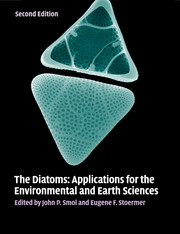Book contents
- Frontmatter
- Contents
- List of contributors
- Preface
- Part I Introduction
- Part II Diatoms as indicators of environmental change in flowing waters and lakes
- Part III Diatoms as indicators in Arctic, Antarctic, and alpine lacustrine environments
- 12 Diatoms as indicators of environmental change in subarctic and alpine regions
- 13 Freshwater diatoms as indicators of environmental change in the High Arctic
- 14 Diatoms as indicators of environmental change in Antarctic and subantarctic freshwaters
- Part IV Diatoms as indicators in marine and estuarine environments
- Part V Other applications
- Part VI Conclusions
- Glossary, acronyms, and abbreviations
- Index
- References
13 - Freshwater diatoms as indicators of environmental change in the High Arctic
from Part III - Diatoms as indicators in Arctic, Antarctic, and alpine lacustrine environments
Published online by Cambridge University Press: 05 June 2012
- Frontmatter
- Contents
- List of contributors
- Preface
- Part I Introduction
- Part II Diatoms as indicators of environmental change in flowing waters and lakes
- Part III Diatoms as indicators in Arctic, Antarctic, and alpine lacustrine environments
- 12 Diatoms as indicators of environmental change in subarctic and alpine regions
- 13 Freshwater diatoms as indicators of environmental change in the High Arctic
- 14 Diatoms as indicators of environmental change in Antarctic and subantarctic freshwaters
- Part IV Diatoms as indicators in marine and estuarine environments
- Part V Other applications
- Part VI Conclusions
- Glossary, acronyms, and abbreviations
- Index
- References
Summary
Introduction
High Arctic environments continue to receive increased attention from the scientific community, policy makers, and the public at large because polar regions are considered to be especially sensitive to the effects of global climatic and other environmental changes (Rouse et al., 1997; ACIA, 2004; IPCC, 2007). Polar lakes and ponds, and the biota they contain, are important sentinels of environmental changes (Pienitz et al., 2004; Schindler & Smol, 2006) and have thus been the focus of many research programs (Vincent & Laybourn-Parry, 2008).
There is considerable potential for using living and fossil diatom assemblages to track environmental trends in High Arctic regions (Smol & Douglas, 1996; Douglas et al., 2004a). A growing number of studies have examined the taxonomy, ecology, and paleoecology of High Arctic diatoms, as lakes and ponds are dominant features of most Arctic landscapes. Given the diversity and vastness of these regions, many exciting research opportunities exist. For example, about 18% (by area) of Canada's surface waters are situated north of 60 °N (Statistics Canada, 1987), and Sheath (1986) estimated that tundra ponds cover approximately 2% of the Earth's surface. The heightened interest in High Arctic environments, coupled with an increased accessibility of these remote regions (e.g. by helicopter), has resulted in a recent surge of interest in Arctic diatom research. Whilst some proxy techniques, such as palynology and dendroecology, have limited applicability in some High Arctic regions due to the paucity of higher plants (Gajewski et al., 1995), paleolimnological approaches using diatoms have become especially important for studies of long-term global environmental change.
- Type
- Chapter
- Information
- The DiatomsApplications for the Environmental and Earth Sciences, pp. 249 - 266Publisher: Cambridge University PressPrint publication year: 2010
References
- 40
- Cited by

